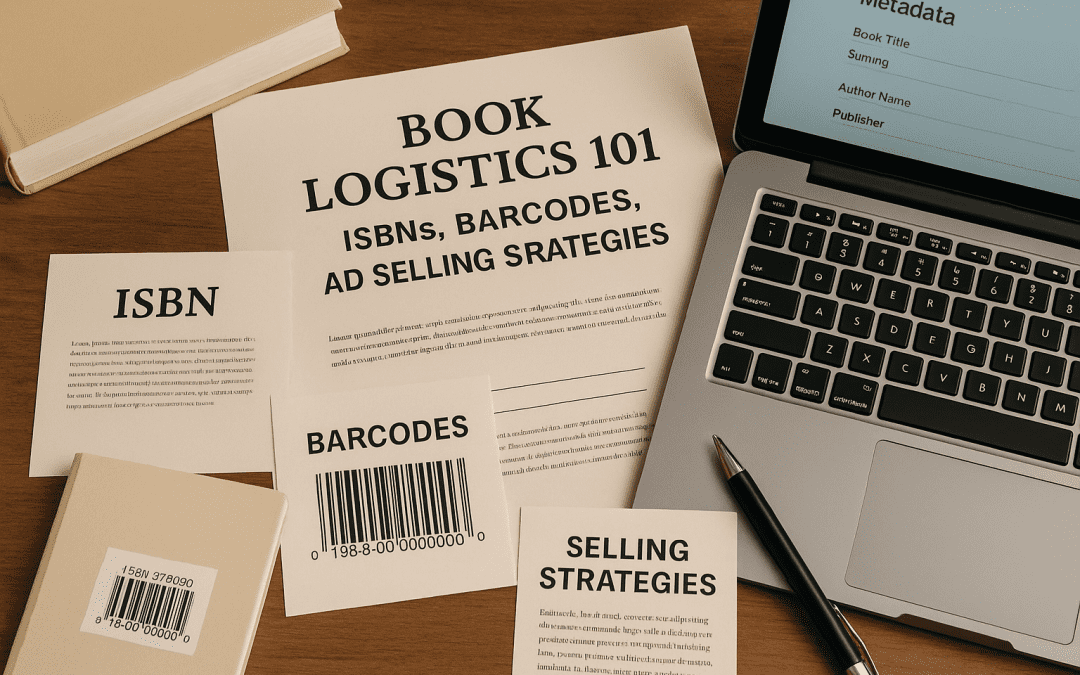Completing a manuscript is a milestone. Still, preparing it for readers requires understanding the essential logistics of book publishing. From ISBNs and barcodes to pricing and distribution, these behind-the-scenes elements are crucial for getting your book into the hands of readers. This guide to book publishing logistics will help you take those next steps with clarity.
ISBNs: What They Are and Why They Matter in Book Publishing Logistics
An ISBN (International Standard Book Number) is a 13-digit code that uniquely identifies your book. It’s essential for cataloging, distribution, and retail sales.
Should You Get One?
- Authors using Amazon KDP can get a free ISBN. Just know that Amazon will appear as the publisher of record.
- Writers wanting full publishing control and broader distribution often choose to purchase ISBNs from Bowker (in the U.S.). You can do this at Bowker’s official website.
One Format, One ISBN
Each format—print, ebook, or audiobook—requires a separate ISBN. This ensures proper tracking across all versions.
Barcodes: A Critical Piece of Book Publishing Logistics
Once you’ve secured your ISBN, you can generate a barcode for your physical book. This barcode helps retailers scan and track sales.
Make sure to reserve space—typically on the lower-right back cover—for the barcode.
Metadata: The Key to Discoverability
Metadata includes the key details that help readers and retailers discover your book. When optimized correctly, it boosts your visibility on platforms like Amazon, Kobo, and Apple Books.
Elements of Metadata:
- Book title and subtitle
- Author name
- ISBN
- Publisher name
- Book description
- BISAC categories (genre classification)
- Relevant keywords
Effective metadata allows your book to appear in search results and ensures it’s categorized correctly across retailers and databases.
Want to boost your book’s visibility even more? See our guide on how metadata impacts book visibility.
Choosing Between Print-on-Demand and Bulk Printing for Book Publishing Logistics
Print-on-Demand (POD)
POD services like Amazon KDP and IngramSpark print and ship books as orders are received. This approach minimizes upfront costs and is ideal for indie authors or those publishing on a budget.
Bulk Printing
In contrast, bulk printing gives you lower costs per book but requires a larger initial investment. It’s best for those planning to sell at events, through bookstores, or on personal websites.
Distribution: Broad Reach vs. Exclusive Agreements
Wide Distribution
Selling your book across multiple retailers—Amazon, Barnes & Noble, Apple Books, Kobo, and more—gives you access to a broader audience and long-term flexibility.
Exclusive Distribution
Programs like Amazon’s KDP Select offer perks such as Kindle Unlimited inclusion. However, your ebook must be exclusive to Amazon during the enrollment period, which may limit your reach.
Setting Your Book’s Price
A thoughtful pricing strategy can influence your book’s success. Consider the following general guidelines:
- Ebooks: $2.99–$5.99 for optimal accessibility and royalties
- Paperbacks: $10–$18, based on length and printing costs
- Hardcovers: $18–$30+, typically positioned as premium editions
Make sure the price covers production and generates a profit. Need help with book marketing? Read our guide on how to hook readers with your blurb.
The Benefits of Owning Your ISBN
Purchasing your own ISBN provides greater control over your publishing process. Benefits include:
- Publishing under your own imprint
- Eligibility for bookstore and library distribution
- Enhanced credibility and independence as an author
- The ability to sell directly from your website
Using a platform-issued ISBN may limit some of these opportunities.
Pre-Publication Checklist
Before you release your book, confirm the following:
- ISBNs have been assigned for each format
- Barcode is properly placed on your print edition
- Metadata is accurate and complete
- A clear pricing strategy is set
- You’ve chosen between POD and bulk printing
- Distribution strategy is finalized
Final Thoughts
Publishing a book goes far beyond writing it. Understanding book logistics—like ISBNs, metadata, pricing, and distribution—equips you with the tools to publish professionally and reach your target audience. With a solid strategy and clear information, you’ll be ready to take the next step in your publishing path.
Have questions about ISBNs or choosing the right print option? Share your thoughts in the comments—we’re here to help you navigate the publishing process with confidence.







